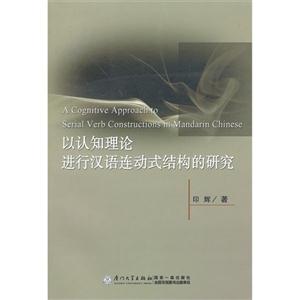-
>
心理学经典文丛:女性心理学
-
>
贫困一代:被社会囚禁的年轻人
-
>
乌合之众:大众心理研究(英汉双语修订版)(套装共2册)
-
>
始于极限:女性主义往复书简
-
>
融合文化(新媒体和旧媒体的冲突地带)/文化和传播译丛
-
>
看不见的女性
-
>
县乡中国:县域治理现代化
以认知理论进行汉语连动式结构的研究 版权信息
- ISBN:9787561545270
- 条形码:9787561545270 ; 978-7-5615-4527-0
- 装帧:一般胶版纸
- 册数:暂无
- 重量:暂无
- 所属分类:>>
以认知理论进行汉语连动式结构的研究 本书特色
《以认知理论进行汉语连动式结构的研究》旨在解决汉语语言学的一个长期存在的问题,即如何分类和理解svc(汉语连动式结构)。作者对svc的分类是基于三形象语义原则:时间序列和范围,共享参与者,和情境依赖。
以认知理论进行汉语连动式结构的研究 内容简介
Thisstudyaimsatsolvingalong-standingprobleminMandarinlinguistics,namelyhowtocategorizeandunderstandtheplethoraofconstructionsthathavebeencalledSVCs(SerialVerbConstructions)atonetimeoranother.Thisstudyexaminesfeatureswhichdifferentiatethemfromtypicalcasesofcoordination,subordination.ItdemonstratesthatthemaindifferencesbetweenSVCsandnon-SVCslieintheirdifferentprofiles.MyclassificationforanSVCisbasedonthethreeiconicallybasedsemanticprinciples:temporalsequenceandscope,sharedparticipants,andsituationaldependence.Groundedonthesethreeprinciples,sevenmorphosyntacticanclprosodictestshavebeenproposedtoapplytofiveconstructionswhichconsistofmorethanoneverb.Thesevenoperationaliconic/semantictestsallowustocapturecommonfeaturesofSVCsinMandarinChinese.MandarinSVCsreflectcognitivepackaging,thatis,anSVCdenotesaunitarycomplexeverntandreflectseventconflationoftwoormoresub-events.ThefiveconstructionsreflectdegreesofserializationoracontinuumofeventconflationinMandarin.Inthisstudy,twoexperimentsweredesignedtoexplorethephenomenonofeventautonomyoreventconflationofthefive[V(N)V...]typesandtheeffectsofconstrualontheinterpretationofdifferentconstructions.ThefindingsintheexperimentssuggestthatMandannspeakersaresensitivetosentencesexhibitingdifferentdegreesofeventconflation.Theresultsintheexperimentsindicatethateventconflationreallyt.urnedouttobeagradedratherthanadiscretePhenomenon.ThephenomenaofManclarinSVCsprovideevidenceforakindoficonicityoperatinginthecodingofmulti-verbstructures.
以认知理论进行汉语连动式结构的研究 目录
chapter 1 introductionchapter 2 past treatments of serial verb constructions 2.1 past approaches to svcs 2.1.1 christaller (1875) 2.1.2 westermann (1930) 2.1.3 stewart ( 1963 ) 2.1.4 bamgbose (1974) 2.1.5 baker (1989) 2.1.6 agbedor (1994) 2.1.7 aikhenvald ( 2006 ) 2.2 past approaches to chinese svcs 2.2.1 chao (1968) 2.2.2 li and thompson ( 1981 ) 2.2.3 dai (1990) 2.2.4 paul (2004) 2.3 discussionchapter 3 basic tenets of cognitive grammar 3.1 assumptions of cognitive grammar 3.2 symbolization 3.3 construction and composition 3.4 base vs.profile 3.5 construal 3.6 perspective 3.7 action chain 3.8 lexicon and syntax 3.9 schematic representation of a transitive eventchapter 4 the present analysis 4.1 three iconically based semantic principles 4.1.1 principle of temporal sequence and scope 4.1.2 principle of shared participants 4.1.3 principle of situational dependence 4.2 conceptual event 4.3 laying out the event conflation continuum 4.4 event structure of coordination, subordination, and svcs 4.5 morphosyntactic and prosodic tests of event conflation chapter 5 the five constructions and the seven tests 5.1 coordinate constructions 5.1.1 schematic representation 5.1.2 application of tests 5.1.3 discussion 5.2 complement constructions 5.2.1 schematic representation 5.2.2 application of tests 5.2.3 discussion 5.3 purposive constructions 5.3.1 purposive complements or separate clauses 5.3.2 the three principles reflected in purposive svcs 5.3.3 schematic representation 5.3.4 application of the tests 5.3.5 discussion 5.4 double-headed or shared object constructions 5.4.1 the three principles reflected in double-headedconstructions 5.4.2 schematic representation 5.4.3 application of tests 5.4.4 discussion 5.5 the so-called vv compounds--a continuum between lexicon andsyntax 5.5.1 parallel vv compounds 5.5.2 phase vv compounds 5.5.3 resultative vv compounds 5.5.4 directional vv compounds 5.6 vv compounds as svcs 5.6.1 svcs with complements of result 5.6.2 svcs with complements of direction 5.6.3 schematic representation 5.6.4 application of tests 5.7 discussionchapter 6 coverb constructions 6.1 traditional criteria 6.2 problematic criteria 6.3 verbhood tests 6.4 present analysis 6.4.1 coverbs--a continuum 6.4.2 entities undergoing process 6.5 metaphorical and functional extensions 6.5.1 na 'take' ——instrumental and topic marker 6.5.2 ba——object marker 6.5.3 gel (give) ——recipient marker and benefactive use 6.6 differences between svcs and covcschapter 7 psycholinguistic experiments 7.1 experiment one 7.2 experiment twochapter 8 the association of multi-verb constructions with verbs 8.1 coordinate construction 8.2 complement construction 8.3 purposive construction 8.4 shared object construction 8.5 compound construction 8.5.1 contiguous compounds containing lai ' come' and qu ' go' 8.5.2 contiguous compounds containing motion verbs other thanlai and quchapter 9 conclusionsbibliography
- >
诗经-先民的歌唱
诗经-先民的歌唱
¥15.1¥39.8 - >
新文学天穹两巨星--鲁迅与胡适/红烛学术丛书(红烛学术丛书)
新文学天穹两巨星--鲁迅与胡适/红烛学术丛书(红烛学术丛书)
¥9.9¥23.0 - >
我与地坛
我与地坛
¥25.8¥28.0 - >
月亮与六便士
月亮与六便士
¥13.4¥42.0 - >
我从未如此眷恋人间
我从未如此眷恋人间
¥37.4¥49.8 - >
史学评论
史学评论
¥18.5¥42.0 - >
【精装绘本】画给孩子的中国神话
【精装绘本】画给孩子的中国神话
¥17.6¥55.0 - >
名家带你读鲁迅:故事新编
名家带你读鲁迅:故事新编
¥13.0¥26.0
-
咬文嚼字二百问
¥10.9¥32 -
为生命而阅读
¥21.4¥42 -
语言常识全知道
¥42.8¥68 -
殷墟花园庄东地甲骨文字编
¥51.7¥76 -
古代汉语(校订重排本)(第2册)
¥12.9¥23 -
公文高手的25项写作技巧
¥38.5¥55















